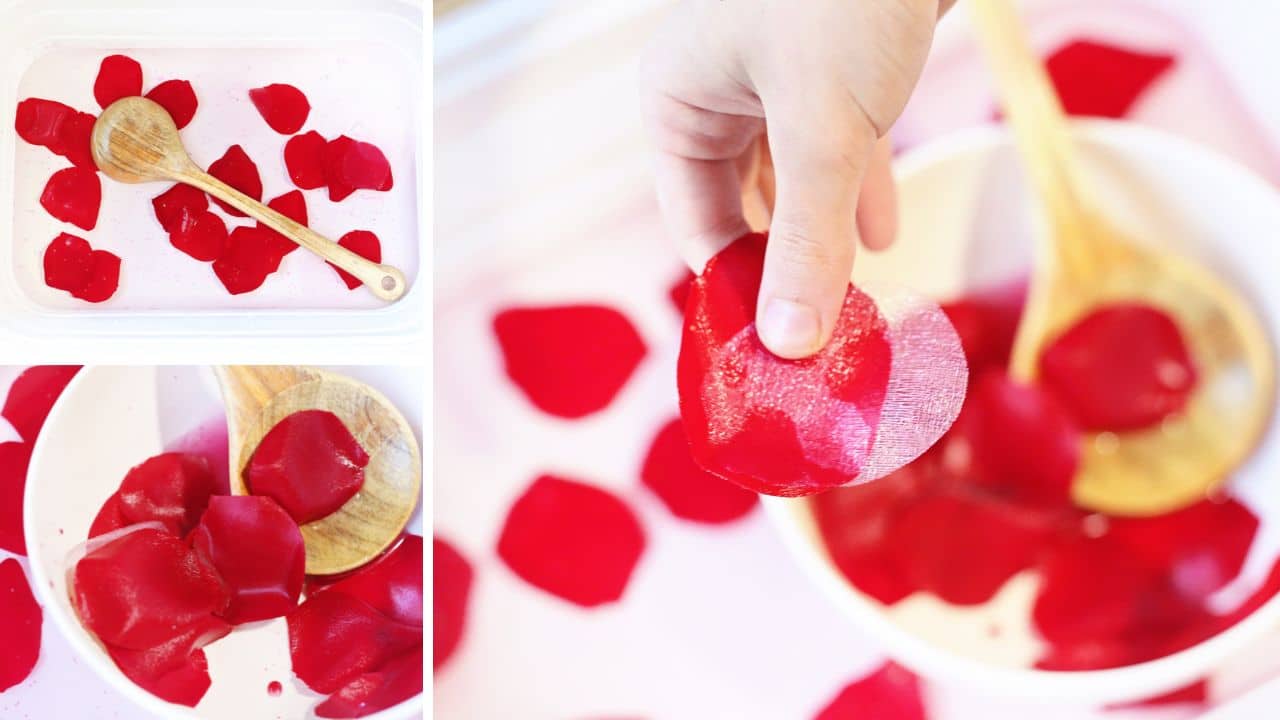Valentine’s Day isn’t just about candy and cards—it’s also the perfect excuse for a little sensory magic.
This Rose Petal Valentine Soup Sensory Bin is a dreamy, water-based activity that engages kids’ senses while encouraging imagination and creativity. It’s simple to set up and creates a calming, hands-on experience that toddlers and preschoolers will love.
The soft petals, sparkly water, and pretend soup-making all combine for an activity that feels just as lovely as it looks.
Supplies and Materials

To create your Valentine’s sensory bin, you’ll need:
- Rose petals (real or artificial)
- Glitter (biodegradable is a bonus)
- Bowl (light plastic works great)
- Spoon or ladle
- Water
- Optional: red or pink food coloring
You can grab a pack of faux rose petals at any dollar store, or use real ones if you want to make it even more sensory-rich.
Instructions & Play Suggestions

- Start with Water: Fill a plastic bin about one-third full of warm or room temperature water. If using food coloring, add a drop or two now to create a soft pink hue.
- Add the Magic: Sprinkle in the rose petals and glitter. Let the glitter swirl and settle—it adds a little sparkle that feels festive and fun.
- Set Up for Play: Drop in the bowl and spoon. Keep a few rose petals off to the side so kids can explore the difference between dry and wet textures.
- Pretend Cooking: Invite your child to scoop petals and glittery water into the bowl to create their own Valentine soup. Talk about what ingredients they’re using, what it smells or feels like, and how they might serve it.
- Sensory Exploration Ideas:
- Have your child dip a dry petal in water and watch how it transforms. Some fake petals become sheer or change color when wet.
- Ask them how the textures compare: wet vs. dry, smooth vs. crinkly, slippery vs. soft.
- If using real petals, ask if they notice a scent difference after they soak.
Benefits of the Rose Petal Valentine Soup Bin

- Sensory Exploration: From warm water to soft petals to floating glitter, this bin stimulates sight, touch, and smell (especially with real petals).
- Emotional Regulation: Water play can be soothing and calming for young children, making it a great quiet-time activity.
- Language Development: Describing textures, colors, and pretend ingredients helps build vocabulary and storytelling skills.
- Fine Motor Skills: Scooping petals and pouring water into small containers strengthens little hands and coordination.
- Creative Thinking: Pretend play helps kids express themselves and use their imagination in new ways.
Frequently Asked Questions
What age is this activity for?
This sensory bin is best for toddlers and preschoolers (around age 2+). Always supervise children closely, especially during water play.
Can I use real rose petals?
Yes! Real petals are safe and smell amazing. Just be aware they may break down quickly in water, especially if played with for a while.
Do artificial petals work?
Absolutely. They’re often more durable for play, but some types may bleed dye or become sheer when wet—so be prepared for colorful surprises!
Is glitter safe to use?
We recommend using biodegradable glitter if possible. It’s better for the environment and just as sparkly. You can also skip glitter entirely if mess is a concern.
How do I clean up afterward?
Use a strainer to catch the petals and glitter before dumping the water. Toss the petals (real or fake) if they’re too soggy, and rinse out the bin for next time.
Will food coloring stain my bin or child’s hands?
A couple drops shouldn’t stain, especially when diluted in water. Still, test on a small area first and avoid excessive amounts if you’re concerned.
A little water, a sprinkle of sparkle, and some soft petals go a long way in making Valentine’s Day feel magical for your little ones. Whether you’re creating a quiet moment or adding a themed touch to your February activities, this sensory bin is one sweet way to say I love you through play.

Leave a Reply